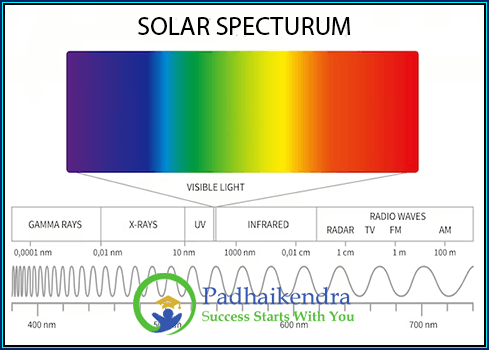The extended solar spectrum refers to the electromagnetic radiation emitted by the Sun across a broad range of wavelengths. While we often associate sunlight with the visible light spectrum, the Sun actually emits radiation across a wide range of wavelengths, extending beyond what is visible to the human eye.
The Sun’s spectrum spans from ultraviolet (UV) radiation with shorter wavelengths to infrared (IR) radiation with longer wavelengths. The entire range is often divided into different regions based on wavelength, including:
Ultraviolet Region (UV Region)
This region of the solar spectrum consists of wavelengths shorter than what is visible to humans, typically ranging from about 10 nanometers (nm) to 400 nm. UV radiation can be further divided into three sub-regions: UV-C (10-280 nm), UV-B (280-315 nm), and UV-A (315-400 nm). UV radiation is responsible for effects such as sunburn and is important for processes like vitamin D synthesis.
Visible Light Region
This is the part of the solar spectrum that is visible to the human eye. It spans wavelengths approximately from 400 nm (violet) to 700 nm (red). Different colors within this range correspond to different wavelengths.
Infrared Region (IR Region)
 The infrared region of the solar spectrum consists of longer wavelengths than those of visible light. It can be further divided into three categories: near-infrared (NIR) (700-1400 nm), mid-infrared (MIR) (1400-3000 nm), and far-infrared (FIR) (3000 nm – 1 mm). Infrared radiation is associated with heat, and its longer wavelengths are used in applications like remote sensing and thermal imaging.
The infrared region of the solar spectrum consists of longer wavelengths than those of visible light. It can be further divided into three categories: near-infrared (NIR) (700-1400 nm), mid-infrared (MIR) (1400-3000 nm), and far-infrared (FIR) (3000 nm – 1 mm). Infrared radiation is associated with heat, and its longer wavelengths are used in applications like remote sensing and thermal imaging.
Understanding the extended solar spectrum is important for various fields of study, including solar energy, atmospheric science, astronomy, and spectroscopy. Different regions of the solar spectrum have distinct interactions with Earth’s atmosphere and are responsible for various physical and chemical processes.
Scientists use instruments such as spectrometers and telescopes to study the extended solar spectrum and its components. By analyzing the radiation emitted by the Sun at different wavelengths, researchers can gain insights into solar physics, atmospheric composition, climate patterns, and other phenomena related to electromagnetic radiation from our closest star, the Sun.
Solar spectrum FAQs
The solar spectrum refers to the distribution of electromagnetic radiation emitted by the Sun across a range of wavelengths. It encompasses the entire electromagnetic spectrum, from radio waves to gamma rays.
The solar spectrum consists of a continuous range of wavelengths, with different intensities at each wavelength. It contains all the colors of visible light, along with infrared (IR) and ultraviolet (UV) regions.
The solar spectrum is produced by the Sun's nuclear fusion process. It arises from the high temperatures and pressures within the Sun's core, causing the emission of electromagnetic radiation at various wavelengths.
The solar spectrum is important because it provides crucial information about the Sun's energy output and composition. It allows us to study and understand solar physics, Earth's climate, and enables various applications such as solar energy generation and astronomical research.
The solar spectrum can be divided into several regions, including radio waves, microwave, infrared, visible light, ultraviolet, X-rays, and gamma rays. Each region has distinct characteristics and interactions with matter.
The solar spectrum is measured using instruments called spectrometers or spectrographs. These devices separate the incoming light into its constituent wavelengths, allowing scientists to analyze the intensity and properties of different wavelengths.
The visible light region of the solar spectrum is particularly important because it is the range of wavelengths that human eyes can perceive. It contains the colors of the rainbow and plays a crucial role in photosynthesis and our daily visual experiences.
The Sun exhibits a continuous spectrum, often referred to as a blackbody or thermal spectrum. It covers a broad range of wavelengths from radio waves to gamma rays, encompassing all colors of visible light as well as infrared and ultraviolet regions.
The solar spectrum contains spectral lines corresponding to various elements present in the Sun. Some prominent elements observed in the solar spectrum include hydrogen, helium, carbon, oxygen, nitrogen, and traces of other metals like iron, magnesium, and calcium.
The complete range of solar radiation wavelengths in the spectrum extends from approximately 100 nanometers (nm) to 1 millimeter (mm). This range covers various regions, such as radio waves (mm to meters), microwaves, infrared (IR), visible light (400-700 nm), ultraviolet (UV), X-rays, and gamma rays.
 The infrared region of the solar spectrum consists of longer wavelengths than those of visible light. It can be further divided into three categories: near-infrared (NIR) (700-1400 nm), mid-infrared (MIR) (1400-3000 nm), and far-infrared (FIR) (3000 nm – 1 mm). Infrared radiation is associated with heat, and its longer wavelengths are used in applications like remote sensing and thermal imaging.
The infrared region of the solar spectrum consists of longer wavelengths than those of visible light. It can be further divided into three categories: near-infrared (NIR) (700-1400 nm), mid-infrared (MIR) (1400-3000 nm), and far-infrared (FIR) (3000 nm – 1 mm). Infrared radiation is associated with heat, and its longer wavelengths are used in applications like remote sensing and thermal imaging.




